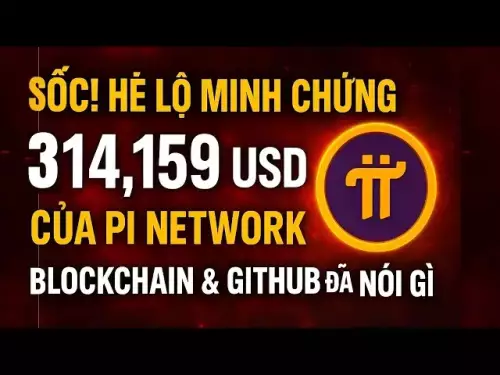 |
|
 |
|
 |
|
 |
|
 |
|
 |
|
 |
|
 |
|
 |
|
 |
|
 |
|
 |
|
 |
|
 |
|
 |
|
Cryptocurrency News Articles
The Importance of Data Visibility in the Circulating Supply of Tokens
May 15, 2025 at 12:27 pm
In the rapidly evolving realm of cryptocurrency, data visibility is frequently extolled as a central principle. Nevertheless, when it pertains to one of the most vital indicators

In the rapidly evolving realm of cryptocurrency, data visibility is frequently extolled as a central principle. However, when it pertains to one of the most vital indicators in tokenomics—the circulating supply—things are still not very clear.
Many traders and speculators rely on figures from sites such as CoinGecko or CoinMarketCap, which they assume to be accurate accounts of how many tokens are currently in circulation. But the Honest Tokenomics team has some serious doubts.
The space between perception and reality can have some big consequences for investment choices, token valuation, and project credibility. To give you an idea of the gravity of the situation, let’s unpack the difference between ‘unlocked supply’ and ‘circulating supply’; and to understand why this is especially critical right now, let’s look at a real-world example: $CONX.
Understanding the Two Types of Supply
This matter revolves around two distinct metrics of supply: unlocked supply and circulating supply. They might appear to be the same, but they narrate entirely different tales.
Released supply refers to the number of tokens that have been issued according to the vesting schedule laid out in the project’s whitepaper. These tokens are liquid—they are no longer locked by smart contracts or other restrictions. However, just because tokens are released doesn’t mean they’re actively being traded or held by the public. This category often includes tokens allocated for foundation, team reserves, or marketing efforts, as well as staking rewards. While these tokens are “available,” they might still be held by insiders or entities with no immediate intention to sell.
On the other hand, circulating supply should be understood as the number of tokens actually in the hands of the market—tokens that are tradable and, ideally, in active use. But here’s the catch: Unlike real public companies, blockchain projects have no legal obligation to disclose anything to anyone. So Circulating supply figures are often self-reported by project teams to data aggregators like CoinGecko. This means the accuracy of this number depends largely on how diligent and transparent the teams are in maintaining their own data.
The $CONX Case Study: A Cautionary Tale
To show how this difference works out in real time, let’s consider $CONX, a token that has been heating up and has lately drawn attention for its supply data mismatch.
The project’s whitepaper and vesting documents indicate that more than 62 million $CONX tokens are currently unlocked. This should imply that a serious amount of liquidity actually exists, likely in team wallets, foundation reserves, or designated ecosystem funds.
What’s the real circulating supply of a token?
Nobody really knows, sometimes not even the team themselves.
That’s why our team is laser-focused on revealing the supply truth.
If you've looked at $CONX lately, you might’ve seen two numbers:
• Unlocked Supply•… pic.twitter.com/rxE9uwsMoq— Tokenomist (prev. TokenUnlocks) (@Tokenomist_ai) May 13, 2025
However, if you examine the circulating supply figures on CoinGecko, they indicate only about 1.15 million tokens—a token that appears not to have budged in many months.
This glaring gap—over 60 million tokens—isn’t just a technicality. It has serious implications for anyone assessing the token’s market cap, liquidity, and risk profile. If an investor mistakenly thinks that only 1.15 million tokens exist in the market, they might make decisions based on a misguided understanding of the token’s market cap or price volatility. Whereas the truth is that tens of millions of tokens could become active any time now.
It’s not to say the team behind $CONX is trying to mislead investors. Sometimes teams don’t update the circulating supply figures very often, and sometimes they take a more conservative approach and only count tokens that are actively distributed. But without the circulating supply number being up-to-date and accurate, market participants are left to guess and make decisions that are sometimes very ill-informed.
Why Supply Transparency Matters
Comprehending token supply is more than merely an academic exercise—it is a foundation of robust investment analyses. The supply side of unlocked tokens sheds further light on a project’s token dynamics. But it is by no means the sole or even the primary tool used to investigate such matters. Supply and demand, the twin pillars of all economic analysis, also underpin the way we think about unlocked tokens. And even though we use them in the context of the Investable Universe, they are economic tools of general applicability.
The circulating supply that is reported can still be a very useful and helpful snapshot to have—especially when it is maintained and audited carefully. That said, it should never be taken at face value. The perception of the market can be distorted, as was the case with $CONX, by reported figures that
Disclaimer:info@kdj.com
The information provided is not trading advice. kdj.com does not assume any responsibility for any investments made based on the information provided in this article. Cryptocurrencies are highly volatile and it is highly recommended that you invest with caution after thorough research!
If you believe that the content used on this website infringes your copyright, please contact us immediately (info@kdj.com) and we will delete it promptly.





























































